Is Egypt on your bucket list? With its ancient artifacts, rich culture and beautiful landscapes, it’s little wonder this largest of African countries tops the list of many travelers’ dream vacations. (And with so many great deals right now, 2020 is the year to visit!)
Egypt is home to some of the world’s oldest and most notable examples of civilization, including seven UNESCO World Heritage Sites. A special designation given to select landmarks, UNESCO sites are meant to protect the world’s most important historical, cultural and natural heritage. From the Great Pyramid of Giza and the Luxor Temple to historic Cairo and ancient Christian cities—don’t miss these seven amazing places in Egypt.
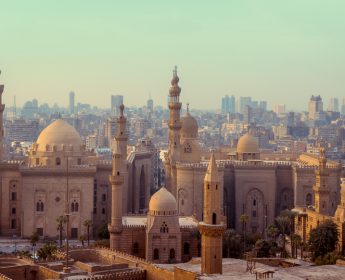 #1 Cairo Historic City – The Saladin Citadel
#1 Cairo Historic City – The Saladin Citadel
As the capital of Egypt, the bustling city of Cairo is home to over 16 million people (that’s roughly a quarter of all Egyptians). Nestled in this modern city lies the Cairo Historic City, one of the world’s largest Islamic districts. Famous for its mosques, madrassas and fountains, this citadel was founded in the 10th century and became the center of the Islamic World, reaching its peak in the late 14th century. One of its grandest mosques is the Mohamed Ali which, at 52 meters tall, dominates the city’s skyline. Take a tour of the historic city and experience the Mosque of Ibn Tulun, Al-Azhar University which world’s oldest university, and Al-Hakim Mosque among other buildings.
Other must-see attractions in Cairo:
Be sure to visit Cairo’s National Museum which houses more than 250,000 Egyptian artifacts, including much of the gold-laden contents of King Tut’s tomb. (Even if you have plans to visit the Great Pyramid of Giza and the Valley of the Kings, many of the treasures from those tombs are now here.) Enjoy a day trip that also stops at the Khan el-Khalili Bazaar, a bustling outdoor mall that is about 500 years old.
#2 Memphis and its Necropolis – The Pyramid Fields from Giza to Dahshur
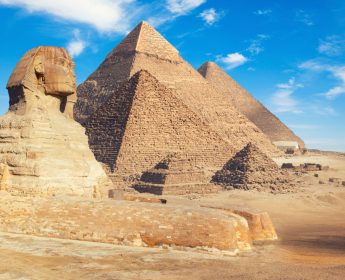 Home to some of Egypt’s most ancient and awe-inspiring structures, this former capital of the Old Kingdom features the famous pyramids and the mysterious Sphinx. Originally covered in glistening limestone, the pyramids were built as tombs for the great pharaohs (or kings) and contained everything they desired to take with them to the afterlife (including their bodies, treasures and even some of their favorite people!) The largest and most famous is the Great Pyramid of Giza which is the last standing wonder of the ancient world. Built for the Pharaoh Cheops, the pyramid took over 100,000 laborers working for 20 years to construct it.
Home to some of Egypt’s most ancient and awe-inspiring structures, this former capital of the Old Kingdom features the famous pyramids and the mysterious Sphinx. Originally covered in glistening limestone, the pyramids were built as tombs for the great pharaohs (or kings) and contained everything they desired to take with them to the afterlife (including their bodies, treasures and even some of their favorite people!) The largest and most famous is the Great Pyramid of Giza which is the last standing wonder of the ancient world. Built for the Pharaoh Cheops, the pyramid took over 100,000 laborers working for 20 years to construct it.
Walk around the pyramid to experience its immensity or, for an extra fee, travel to the center through one of its long corridors to stand inside the king’s tomb. Nearby, marvel at the Great Sphinx of Giza. Although there are a number of statues depicting these mythical creatures throughout Egypt, this one is the oldest known monumental structure in the country (and one of the world’s largest and oldest statues).
How to see the Giza Plateau:
Located just outside Cairo, there are many single day and multiday tours that take visitors here. Some of them even offer camel rides to the area!
#3 Ancient Thebes With Its Necropolis
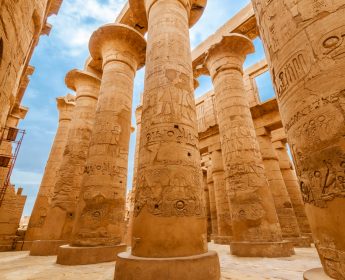 Located south of Cairo, Thebes was once the capital of the New Kingdom of Egypt and home to the country’s wealthiest people. It now lies within the modern city of Luxor on the eastern bank of the Nile. Many of its structures are still in good shape and walking around its ruins is like visiting an open-air museum.
Located south of Cairo, Thebes was once the capital of the New Kingdom of Egypt and home to the country’s wealthiest people. It now lies within the modern city of Luxor on the eastern bank of the Nile. Many of its structures are still in good shape and walking around its ruins is like visiting an open-air museum.
Experience the Luxor Temple built around 1400 B.C. to worship Amun Ra, the King of the Gods. Follow the remains of the Avenue of Sphinxes, a one-and-a-half-mile statue-lined promenade that connects the Luxor Temple to the Karnak Temples. Constructed over a period of 1500 years, this great complex was called “the most perfect of places” and served as the most important place of worship in all of Egypt. Covering nearly 200 acres, Karnak is the largest religious building ever made. While it’s hard to see all of it in one visit, be sure to explore the Great Temple of Amun, the Temple of Khonsu and the Temple of Ptah.
A short boat ride across the Nile will take you to the western side of the city to see the Valley of the Kings and the Valley of the Queens. In the times of Thebes, peopled lived on the east side (where the sun rose) and were buried on the west side (where the sun set). Throughout these areas are an unknown number of hidden tombs (only 60 have been discovered so far), including the famous tomb of King Tutankhamun.
How to See Luxor:
Fly over the city in a hot air balloon, embark on a day trip or stop here on a multiday sightseeing cruise down the Nile.
#4 Nubian Monuments from Abu Simbel to Philae
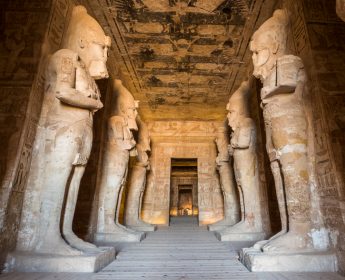 This site is yet another popular area teeming with ancient monuments. Starting at the northern end of Lake Nasser and spanning south along the Nile not far from the Sudan border, this region was saved from being submerged by water with the construction of the Aswan Dam in the 1960s.
This site is yet another popular area teeming with ancient monuments. Starting at the northern end of Lake Nasser and spanning south along the Nile not far from the Sudan border, this region was saved from being submerged by water with the construction of the Aswan Dam in the 1960s.
At Philae, explore the Sanctuary of Isis, one of the last temples built in the classical Egyptian style. Started in 690 B.C., the cult of Isis continued here until 537 A.D. and was one of the last places where the goddess was worshiped. If you visit the temple at night, you can enjoy a spectacular sound and light show. In Abu Simbel, discover the Temple of Ramesses II which features well-preserved statues and colorful walls. Flanked by four large statues of Ramesses II, this magnificent temple was thought to protect Egypt’s southern border (although it was painstakingly moved in 1968 from its original location in order to keep it safe from the Nile’s rising waters).
How to Get to Philae & Abu Simbel:
Take a multiday cruise down the Nile, enjoy a two-week tour that combines the Nubian area with beautiful Red Sea beaches or find a number of day trips from Aswan.
#5 Saint Catherine Area
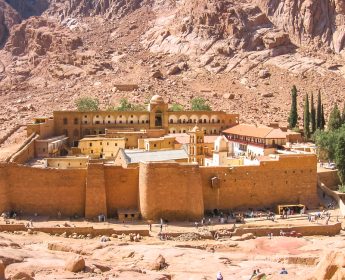 A sacred site to Judaism, Christianity and Islam, St. Catherine’s monastery is located at the base of the Mount Sinai where Moses was said to receive the Ten Commandments. One of the world’s oldest working monasteries, it is also home to the “burning bush.” While here, be sure to view its renowned collection of religious icons, including a 12th-century painting of the Ladder of Divine Ascent. There are a number of day trips to St. Catherine’s departing from Dahab, Sharm El Sheikh and Eilat.
A sacred site to Judaism, Christianity and Islam, St. Catherine’s monastery is located at the base of the Mount Sinai where Moses was said to receive the Ten Commandments. One of the world’s oldest working monasteries, it is also home to the “burning bush.” While here, be sure to view its renowned collection of religious icons, including a 12th-century painting of the Ladder of Divine Ascent. There are a number of day trips to St. Catherine’s departing from Dahab, Sharm El Sheikh and Eilat.
Other UNESCO World Heritage Sites in Egypt
Although not as frequently visited as the locations above, these sites are just as fascinating for the role they play in both cultural and scientific history.
#6 Abu Mena
Located outside Alexandria, Abu Mena was a former Christian holy city built on the tomb of Mena of Alexandre, a Christian martyr. Christianity in Egypt is as old as the religion itself. While most of the town is long gone, the foundations of some of its major buildings such as the great basilica church are still visible.
#7 Wadi al-Hitan (Valley of the Whales)
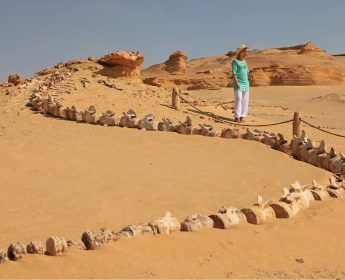 While Egypt’s other UNESCO sites were designated for their cultural significance, Wadi al-Hitan has an important natural one. Known as the “Valley of the Whales,” this area is home to the rare fossilized remains of an extinct whale species. What sets these whales apart from modern day ones? The fossils show the presence of hind legs which helped scientists prove that whales originally evolved from land mammals to ocean species. While not the oldest fossils in the world, the large number and exquisite preservation make this an important site (You can still view entire whale skeletons nestled in the earth). Only about 1,000 visitors travel to this remote area (193 km outside Cairo) each year since it is truly off the beaten path. Part of the reserve was made a tourist venue in recent years and features a brand new museum.
While Egypt’s other UNESCO sites were designated for their cultural significance, Wadi al-Hitan has an important natural one. Known as the “Valley of the Whales,” this area is home to the rare fossilized remains of an extinct whale species. What sets these whales apart from modern day ones? The fossils show the presence of hind legs which helped scientists prove that whales originally evolved from land mammals to ocean species. While not the oldest fossils in the world, the large number and exquisite preservation make this an important site (You can still view entire whale skeletons nestled in the earth). Only about 1,000 visitors travel to this remote area (193 km outside Cairo) each year since it is truly off the beaten path. Part of the reserve was made a tourist venue in recent years and features a brand new museum.
How to See Wadi al-Hitan
Enjoy a two-day tour from Cairo that includes the Sphinx and Giza Plateau before traveling the next day via 4×4 jeep to this fascinating site.
Beyond its seven amazing UNESCO sites, Egypt also offers stunning beaches and luxurious resorts. For more trip ideas to Egypt, click here.
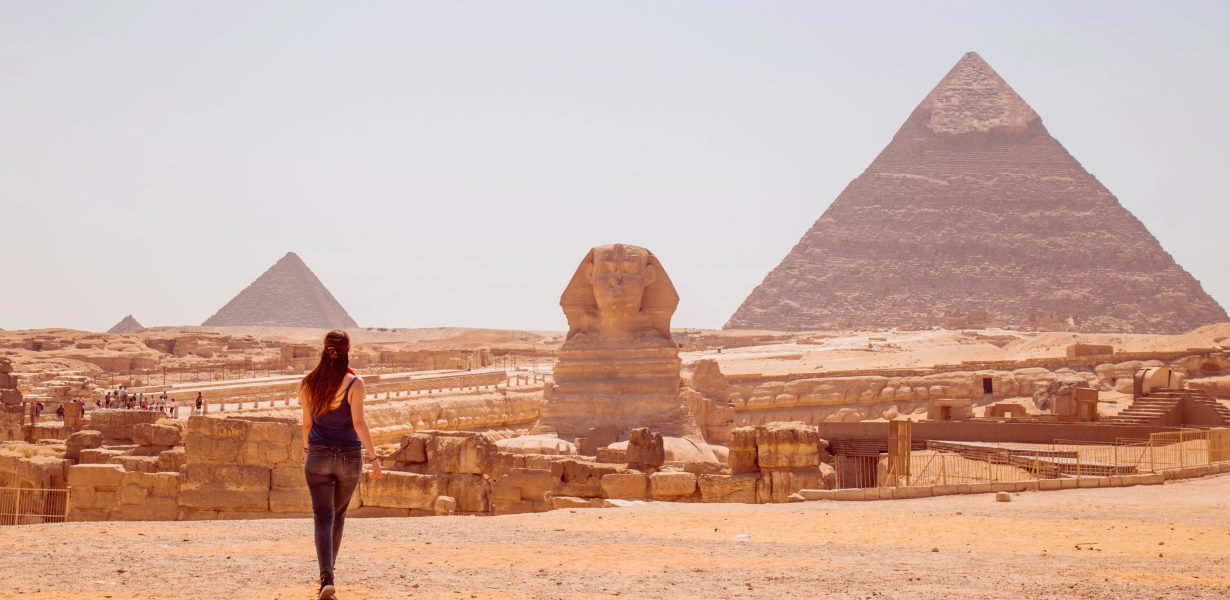





There are no comments.